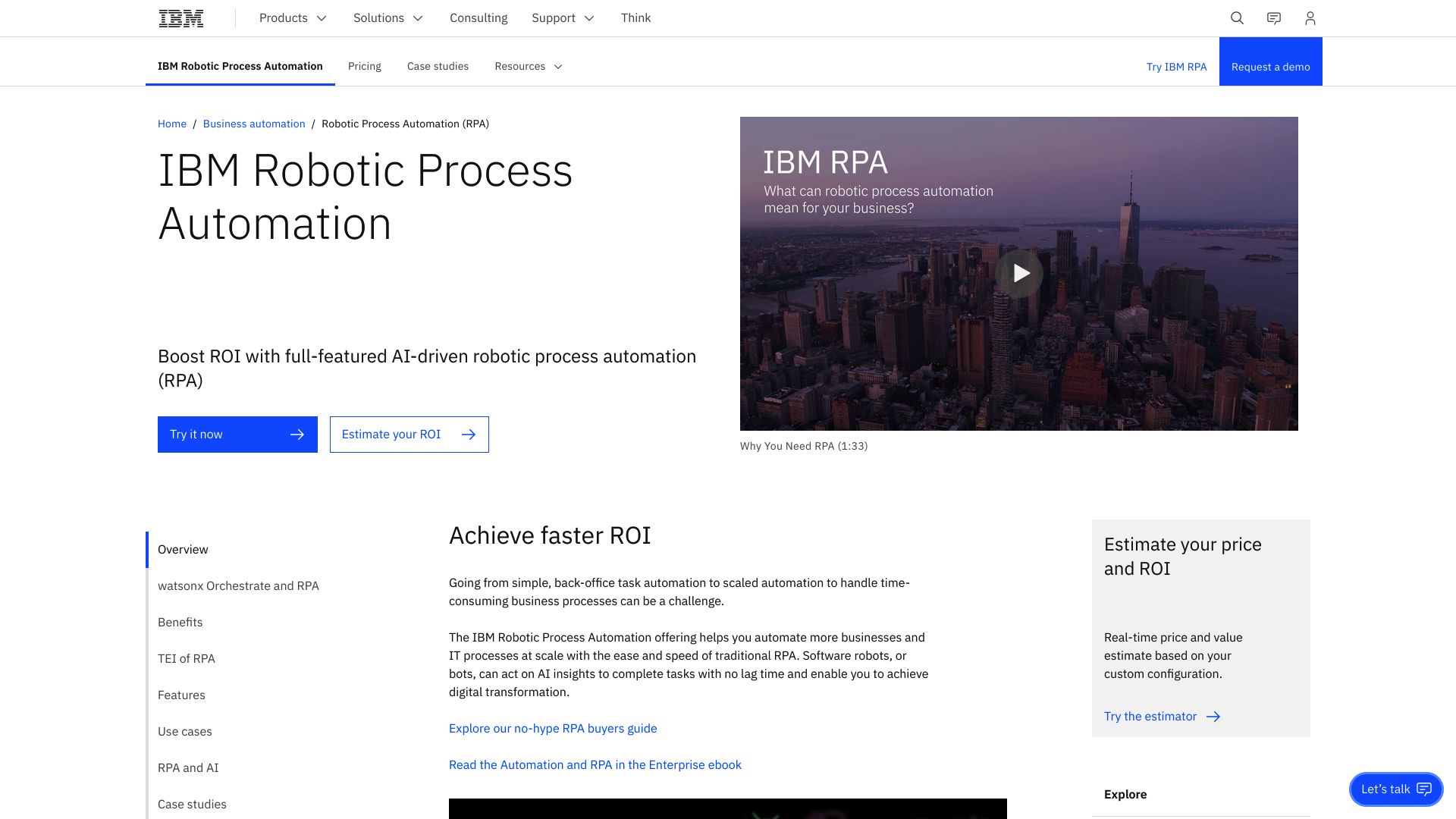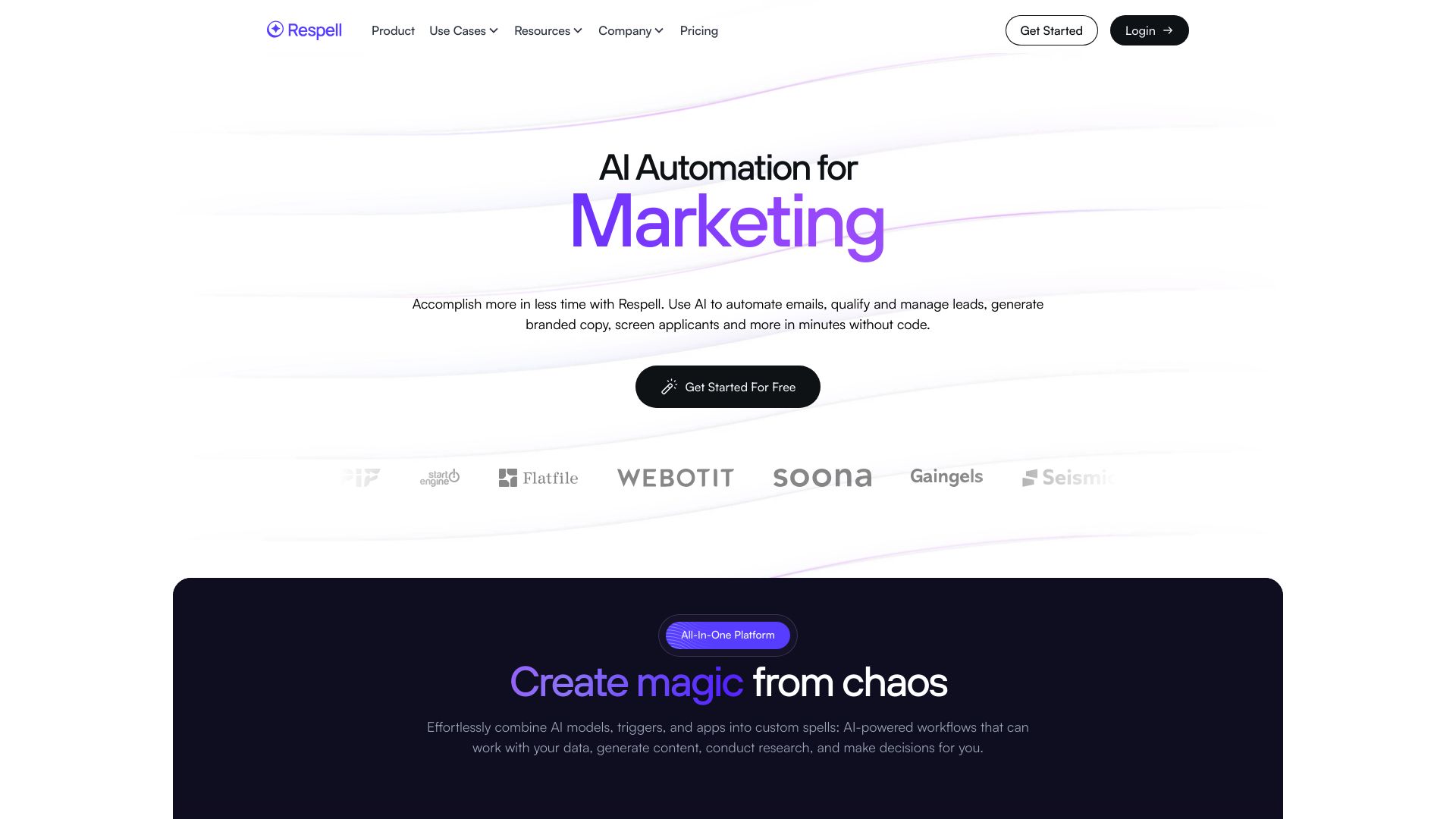IBM RPA vs. Respell: AI Automation Platforms Compared
AI-powered automation platforms are reshaping how businesses operate, boosting efficiency and unlocking new capabilities. This review compares IBM RPA vs. Respell, and SmythOS, three leading solutions in the AI automation space. We’ll explore their key features, strengths, and limitations to help you determine which platform best suits your organization’s needs.
Whether you’re a developer seeking powerful API integrations, a business leader focused on enterprise-grade security, or a non-technical user looking for intuitive no-code tools, this comparison will provide valuable insights to guide your decision-making process. Discover how these platforms tackle automation challenges, enable AI-driven workflows, and empower teams across various industries to harness the full potential of artificial intelligence.
IBM RPA Overview
IBM RPA delivers enterprise-grade automation tools for building, deploying, and managing software bots. These digital workers streamline repetitive tasks across business applications, boosting efficiency and productivity.


IBM RPA’s visual builder empowers both developers and business users to create automation workflows through intuitive drag-and-drop interfaces. The platform supports attended and unattended bots, enabling human-AI collaboration and fully autonomous execution. Integration with watsonx Orchestrate infuses AI capabilities, allowing bots to understand context, make decisions, and solve complex problems.
IBM RPA’s visual builder empowers both developers and business users to create automation workflows through intuitive drag-and-drop interfaces.
Scalability stands out as a key strength. IBM RPA enables concurrent bot execution and offers distributed runtime environments to handle enterprise workloads. The platform also prioritizes security and compliance, with features like data encryption, audit logging, and integration with IBM OpenPages for comprehensive governance.
While IBM RPA excels in enterprise environments, its complexity may present a learning curve for smaller organizations or individual users. Additionally, the platform’s focus on traditional RPA workflows means it may not offer the same level of advanced AI agent capabilities found in some newer, specialized platforms.
IBM RPA integrates seamlessly with common enterprise applications, APIs, and legacy systems. This versatility allows organizations to automate processes across their entire technology stack, from modern cloud services to mainframe applications. The platform’s ability to extract structured data from unstructured content further enhances its utility in diverse business scenarios.
Respell Overview
Respell empowers users to create AI workflows, automations, and agents without coding expertise. The platform’s intuitive no-code interface democratizes AI development, allowing teams across various industries to harness advanced AI capabilities.
At the core of Respell’s offering is the Spell Studio, a drag-and-drop environment for building customized AI workflows called “spells.” Users can leverage pre-built templates from the Explore Page or craft bespoke solutions tailored to their specific needs. The platform’s Elle AI Assistant further enhances accessibility, enabling natural language interactions to guide users through the entire process of creating and managing AI agents.
Respell empowers users to create AI workflows, automations, and agents without coding expertise. The platform’s intuitive no-code interface democratizes AI development…


Respell excels in its integration capabilities, offering native support for popular platforms like Airtable, Confluence, Google, HubSpot, and Salesforce. The Zapier integration expands this further, connecting Respell to over 6,000 additional services. This extensive connectivity allows businesses to seamlessly incorporate AI-driven processes into their existing workflows.
Respell excels in its integration capabilities… This extensive connectivity allows businesses to seamlessly incorporate AI-driven processes into their existing workflows.
While Respell’s no-code approach makes AI accessible, it may limit the depth of customization for highly specialized use cases. Advanced users might find the platform constraining for complex, custom AI implementations. Additionally, as with many cloud-based services, users should carefully consider data privacy and security implications when handling sensitive information through the platform.
Respell positions itself as a powerful tool for businesses looking to rapidly deploy AI solutions without extensive technical resources. Its focus on usability and integration makes it particularly appealing for small to medium-sized enterprises and teams new to AI implementation. However, larger organizations with complex AI needs may need to evaluate if Respell’s capabilities align with their specific requirements and scalability demands.
Feature Comparison
IBM RPA and Respell offer distinct approaches to automation and AI workflow creation, each with its own strengths and limitations. IBM RPA excels in enterprise-grade robotic process automation, providing robust tools for building and managing software bots across large organizations. Its integration with watsonx Orchestrate infuses AI capabilities, allowing bots to understand context and make decisions. In contrast, Respell focuses on creating AI workflows and agents through a no-code interface, making AI development accessible to a broader audience.
IBM RPA’s strength lies in its scalability and security features, crucial for enterprise environments. It supports concurrent bot execution and offers distributed runtime environments to handle enterprise workloads. The platform also prioritizes security and compliance, with features like data encryption and audit logging. However, Respell may have an edge in user-friendliness, especially for non-technical users, with its intuitive Spell Studio and Elle AI Assistant guiding users through the process of creating AI workflows.
While both platforms offer visual builders and support for API integrations, Respell’s approach appears more geared towards rapid deployment of AI-driven solutions across various use cases. IBM RPA, on the other hand, focuses more on traditional automation tasks and may require more technical expertise to fully utilize its capabilities. This difference highlights a gap in their target audiences and use cases, with IBM RPA catering more to large enterprises with complex automation needs, while Respell aims to democratize AI development for a wider range of users and industries.
Feature Comparison Table
| IBM RPA | Respell | SmythOS | |
|---|---|---|---|
| CORE FEATURES | |||
| AI Agents | ❌ | ✅ | ✅ |
| Memory & Context | ❌ | ✅ | ✅ |
| Autonomous Agents | ❌ | ✅ | ✅ |
| Explainability & Transparency | ❌ | ✅ | ✅ |
| Multimodal | ❌ | ✅ | ✅ |
| Problem-Solving Capabilities | ❌ | ✅ | ✅ |
| Multi-Agent Collaboration | ❌ | ✅ | ✅ |
| Work as Team | ❌ | ✅ | ✅ |
| SECURITY | |||
| Constrained Alignment | ❌ | ❌ | ✅ |
| OAuth | ❌ | ✅ | ✅ |
| IP Control | ❌ | ❌ | ✅ |
| COMPONENTS | |||
| Foundation AIs | ❌ | ✅ | ✅ |
| Huggingface AIs | ❌ | ❌ | ✅ |
| Zapier APIs | ❌ | ✅ | ✅ |
| Classifiers | ❌ | ✅ | ✅ |
| Data Lakes | ❌ | ❌ | ✅ |
| DEPLOYMENT OPTIONS (EMBODIMENTS) | |||
| Deploy as Webhook | ❌ | ✅ | ✅ |
| Staging Domains | ❌ | ❌ | ✅ |
| Production Domains | ❌ | ❌ | ✅ |
| API Authentication (OAuth + Key) | ❌ | ✅ | ✅ |
| Deploy as Site Chat | ❌ | ✅ | ✅ |
| Deploy as GPT | ❌ | ❌ | ✅ |
| DATA LAKE SUPPORT | |||
| Hosted Vector Database | ❌ | ❌ | ✅ |
| Sitemap Crawler | ❌ | ❌ | ✅ |
| YouTube Transcript Crawler | ❌ | ❌ | ✅ |
| URL Crawler | ❌ | ✅ | ✅ |
Best Alternative to IBM RPA and Respell
SmythOS stands out as the superior alternative to IBM RPA and Respell, offering a comprehensive platform for AI agent development and deployment. Our solution combines the power of enterprise-grade automation with the accessibility of no-code AI development, making it the ideal choice for businesses seeking to harness the full potential of AI technology.
Unlike IBM RPA’s focus on traditional robotic process automation or Respell’s emphasis on AI workflows, SmythOS provides a versatile ecosystem for creating truly intelligent, autonomous agents. We offer a visual builder that simplifies the development process, allowing users of all skill levels to create sophisticated AI solutions without extensive coding knowledge. This approach democratizes AI development while maintaining the depth and flexibility required for complex enterprise applications.
SmythOS provides a versatile ecosystem for creating truly intelligent, autonomous agents… allowing users of all skill levels to create sophisticated AI solutions without extensive coding knowledge.
SmythOS excels in its comprehensive feature set, addressing limitations found in both IBM RPA and Respell. Our platform supports multi-agent collaboration, enabling teams of AI agents to work together on complex tasks—a capability not offered by IBM RPA. We also provide advanced memory and context management, ensuring that our agents maintain coherent, context-aware interactions across multiple sessions, surpassing Respell’s capabilities in this area.
One of our key advantages is the unparalleled flexibility in deployment options. While Respell offers some API and integration capabilities, SmythOS goes further by allowing deployment as APIs, webhooks, scheduled agents, and even as GPTs. This versatility ensures that our AI agents can be seamlessly integrated into any existing workflow or system, providing a level of adaptability that neither IBM RPA nor Respell can match.
Moreover, we prioritize scalability and security, offering features like constrained alignment and IP control that are critical for enterprise deployments but absent in Respell’s offering. Our platform also includes a hosted vector database and supports various data lake integrations, enabling efficient handling of large-scale data operations—a capability not prominently featured in either IBM RPA or Respell. With SmythOS, businesses can confidently develop and deploy AI solutions that are not only powerful and versatile but also secure and scalable, truly representing the next generation of AI agent builders.
Conclusion
IBM RPA and Respell offer distinct approaches to automation and AI workflow creation, each with unique strengths. IBM RPA excels in enterprise-grade robotic process automation, providing robust tools for building and managing software bots across large organizations. Respell, on the other hand, focuses on creating AI workflows and agents through an intuitive no-code interface, making AI development accessible to a broader audience.
While both platforms have their merits, SmythOS emerges as the superior choice, combining the best of both worlds and offering additional advanced features. SmythOS provides a powerful drag-and-drop interface for creating complex AI workflows, extensive API integrations, and support for multiple AI models. This versatility allows users to build sophisticated AI agents without extensive coding knowledge, democratizing AI development across industries.
Unlike IBM RPA and Respell, SmythOS offers unparalleled deployment flexibility. Users can deploy their AI agents across various platforms, including popular cloud services, chatbots, and even as ChatGPT plugins. This ’Create Once, Deploy Anywhere’ approach sets SmythOS apart, ensuring that AI solutions seamlessly integrate into existing systems and workflows.
For businesses and individuals looking to harness the full potential of AI, SmythOS stands out as the most comprehensive and user-friendly platform. Its extensive feature set, including multi-agent orchestration, versatile deployment options, and robust security measures, makes it the ideal choice for those seeking to automate processes, improve efficiency, and drive innovation. Explore SmythOS’s diverse range of AI-powered agent templates to jumpstart your AI journey and transform your workflow today.
Last updated:
Disclaimer: The information presented in this article is for general informational purposes only and is provided as is. While we strive to keep the content up-to-date and accurate, we make no representations or warranties of any kind, express or implied, about the completeness, accuracy, reliability, suitability, or availability of the information contained in this article.
Any reliance you place on such information is strictly at your own risk. We reserve the right to make additions, deletions, or modifications to the contents of this article at any time without prior notice.
In no event will we be liable for any loss or damage including without limitation, indirect or consequential loss or damage, or any loss or damage whatsoever arising from loss of data, profits, or any other loss not specified herein arising out of, or in connection with, the use of this article.
Despite our best efforts, this article may contain oversights, errors, or omissions. If you notice any inaccuracies or have concerns about the content, please report them through our content feedback form. Your input helps us maintain the quality and reliability of our information.
